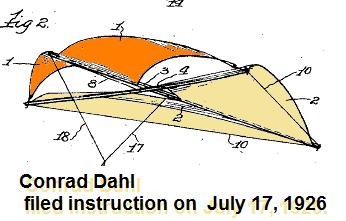Page 2 of November 2010 LIFT
-
Hanggliding
Extreme- Scary landing in Imsdalen-Norway
Discuss?
-
Platz Zeilvliegtuig
-
Hanggliding/Zeilvliegen part 1
-
Hanggliding/Zeilvliegen part 2
-
Fly me to nulle
part (2)
-
Platz Glider
Indoors
-
http://www.youtube.com/watch?v=DXXSnYyEmqg
See
special page about a later 1963/1964 exploration.
- .Filed in 1926 by Conrad Dahl:
 Title: Self-balancing kite.
Title: Self-balancing kite.
Click image for full instructions and claims.
This seems to come close to the adventure found in the Tony Prentice
Splitwing hang glider of 1974c featured in this issue of
Lift
- 1933

Robert F. Bach filed teaching in 1947 for a flying wing with
self-generating airfoil. "Flying-Wing" Kite
Perhaps study this while studying 1887 William Beeson
instruction. And the Wanner kite.


v -
- Filed: March 23, 1964, a cable-leading edge strut-assisted self-generating
airfoil kite:

We do not have the full story on Russell S. Hall's
explorations yet. Click for full patent. This was one of the two
patents featured on the cover of Low & Slow #1 for hang gliding community.
-
- Hiway Explorer ????
-
http://www.flickr.com/photos/donliddard/
-
http://www.flickr.com/photos/donliddard/4885256269/
- M. B. Sellers:
- Sellers in 1907 had cable leading edge made taut by spars and ribs and
sail:

Three patents by George D. Wanner give some flavor of the Eddy or Malay
evolutes that were used at various points of time for free-flight kite-gliders
where the restraint of kite line is replaced with falling masses. -

A version in the Feb 14, 1920, George D. Wanner
instruction.
Wanner also had a bit earlier instruction
in 1919.
Wanner would later give some instruction on robust nose that would hold three
booms without the kite having a crossbar, but depend on the nose piece to the
some spreading of bi-conical lobes of self-generating airfoil; click image for
the 1948 teaching:
 v v
-
- FLYING
MACHINES: CONSTRUCTION and OPERATION
- Chanute: "How Lilienthal Was Killed.
In 1895, Otto Lilienthal, the father of modern aviation, the man to whose
method of experimenting almost all present successes are due, after making
something like two thousand glides with monoplanes, added a superposed
surface to his apparatus and found the control of it much improved. The
two surfaces were kept apart by two struts or vertical posts with a few
guy wires, but the connecting joints were weak and there was nothing like
trussing. This eventually cost his most useful life. Two weeks before that
distressing loss to science, Herr Wilhelm Kress, the distinguished and
veteran aviator of Vienna, witnessed a number of glides by Lilienthal with
his double-decked apparatus. He noticed that it was much wracked and
wobbly and wrote to me after the accident: "The connection of the wings
and the steering arrangement were very bad and unreliable. I warned Herr
Lilienthal very seriously. He promised me that he would soon put it in
order, but I fear that he did not attend to it immediately."
In point of fact, Lilienthal had built a new machine, upon a different
principle, from which he expected great results, and intended to make but
very few more flights with the old apparatus. He unwisely made one too
many and, like Pilcher, was the victim of a distorted apparatus. Probably
one of the joints of the struts gave way, the upper surface blew back and
Lilienthal, who was well forward on the lower surface, was pitched
headlong to destruction. "
-
http://www.premierkites.com/pdf/kites/45880.pdf canard
kite
- v
- v
- v
-
|